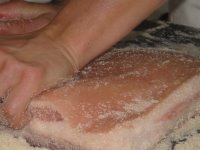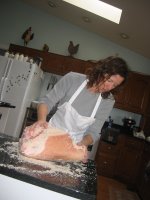
We took our pigs into the butcher on
Monday, April 9th, which was quite an adventure. I picked the meat up Wednesday and began the dry-cure process on Thursday. Tamworth's are known as the "bacon pig," and by the looks of this bacon belly, I can see why. I just hope it tastes as good as it looks!

For the cure, I used a mixture of salt and brown sugar, intentionally leaving out the nitrates. Raising our own meat in order to have as natural a product as possible, and then injecting it with a bunch of nitrates/ nitrites just made no sense. Our butcher offers a city cure, a common mass production method in which a liquid salt/ nitrate brine is injected directly into the meat. Yuk! So, I began to investigate other possibilities. I couldn't find any local smoke houses, so unless we built our own smokehouse, which may happen some day, that wasn't an option. Having grown up with
Virginia ham and biscuits, a dry salt cure was the obvious choice, and I sure appreciated Contrary Goddess's
recent post on salt curing, which made it seem all the more doable for little ol' me.

I rubbed the salt/ sugar mixture into the hams and the bacon slabs, which I cut into manageable sizes for eating and storing. Since we butchered our pigs in April, being from a fall litter rather than a spring litter, we're curing in the bottom of our second fridge instead of using the traditional method of letting Mother Nature provide the appropriate temps—and considering the extended warm weather we enjoyed early this season and the current extended cold, we may have needed the fridge no matter what! I didn't weigh out the hams or the belly, but we probably have close to 80lbs of meat curing. The pigs were 458 live weight, but we didn't get a hanging weight on them. Because we got so many roasts, we ended up with just 15lbs of sausage from the two of them combined, which I mixed up on Friday and vacuum sealed in small packages of loose ground. Before I sealed it, though, I fried up a small patty to check the taste—mmmmmm! It sure was good, and I can't wait to try some of our salty bacon!
 We took our pigs into the butcher on Monday, April 9th, which was quite an adventure. I picked the meat up Wednesday and began the dry-cure process on Thursday. Tamworth's are known as the "bacon pig," and by the looks of this bacon belly, I can see why. I just hope it tastes as good as it looks!
We took our pigs into the butcher on Monday, April 9th, which was quite an adventure. I picked the meat up Wednesday and began the dry-cure process on Thursday. Tamworth's are known as the "bacon pig," and by the looks of this bacon belly, I can see why. I just hope it tastes as good as it looks! For the cure, I used a mixture of salt and brown sugar, intentionally leaving out the nitrates. Raising our own meat in order to have as natural a product as possible, and then injecting it with a bunch of nitrates/ nitrites just made no sense. Our butcher offers a city cure, a common mass production method in which a liquid salt/ nitrate brine is injected directly into the meat. Yuk! So, I began to investigate other possibilities. I couldn't find any local smoke houses, so unless we built our own smokehouse, which may happen some day, that wasn't an option. Having grown up with Virginia ham and biscuits, a dry salt cure was the obvious choice, and I sure appreciated Contrary Goddess's recent post on salt curing, which made it seem all the more doable for little ol' me.
For the cure, I used a mixture of salt and brown sugar, intentionally leaving out the nitrates. Raising our own meat in order to have as natural a product as possible, and then injecting it with a bunch of nitrates/ nitrites just made no sense. Our butcher offers a city cure, a common mass production method in which a liquid salt/ nitrate brine is injected directly into the meat. Yuk! So, I began to investigate other possibilities. I couldn't find any local smoke houses, so unless we built our own smokehouse, which may happen some day, that wasn't an option. Having grown up with Virginia ham and biscuits, a dry salt cure was the obvious choice, and I sure appreciated Contrary Goddess's recent post on salt curing, which made it seem all the more doable for little ol' me. I rubbed the salt/ sugar mixture into the hams and the bacon slabs, which I cut into manageable sizes for eating and storing. Since we butchered our pigs in April, being from a fall litter rather than a spring litter, we're curing in the bottom of our second fridge instead of using the traditional method of letting Mother Nature provide the appropriate temps—and considering the extended warm weather we enjoyed early this season and the current extended cold, we may have needed the fridge no matter what! I didn't weigh out the hams or the belly, but we probably have close to 80lbs of meat curing. The pigs were 458 live weight, but we didn't get a hanging weight on them. Because we got so many roasts, we ended up with just 15lbs of sausage from the two of them combined, which I mixed up on Friday and vacuum sealed in small packages of loose ground. Before I sealed it, though, I fried up a small patty to check the taste—mmmmmm! It sure was good, and I can't wait to try some of our salty bacon!
I rubbed the salt/ sugar mixture into the hams and the bacon slabs, which I cut into manageable sizes for eating and storing. Since we butchered our pigs in April, being from a fall litter rather than a spring litter, we're curing in the bottom of our second fridge instead of using the traditional method of letting Mother Nature provide the appropriate temps—and considering the extended warm weather we enjoyed early this season and the current extended cold, we may have needed the fridge no matter what! I didn't weigh out the hams or the belly, but we probably have close to 80lbs of meat curing. The pigs were 458 live weight, but we didn't get a hanging weight on them. Because we got so many roasts, we ended up with just 15lbs of sausage from the two of them combined, which I mixed up on Friday and vacuum sealed in small packages of loose ground. Before I sealed it, though, I fried up a small patty to check the taste—mmmmmm! It sure was good, and I can't wait to try some of our salty bacon!














4 comments:
Oooh, you need to show me how! We are planning to have a couple of pigs next year.
As for AI'ing your ewes, I'm not sure you'd want any semen from Old Half Price. We got him half off because he's not "show quality" since he has wool on his legs.
One suggestion I have for you: LISTEN to the ewes before you buy them. One of the ones we got has the most offensive voice I have ever heard coming from any animal. She's also the alpha female so she's always bitching about something. If she wasn't such a good mom she'd be in the stew pot by now--she literally drives us all crazy. I should send you some video, you won't believe it.
How is kitty with the swollen face? I hope he is all better. We sure had a great time! Thanks again for having us.
lol Someone on the pig list I'm on just confided that she planned to cull her sow this fall purely because she was so annoyingly vocal--nice lines, productive, good disposition, but annoying.
I'm in the middle of drafting a post about the lambs that I'll post soon.
Christy, we enjoyed having you guys visit. The baby pig has arrived, and we're due to pick up the boys in late May, I think. I'm guessing the sow didn't farrow as early as the woman guessed because the date got pushed back by about a month.
Tabby's doing fine. The swelling went down over the next few days with no apparent ill effects. Must have been a bite.
I'll be salting the hams for the last time today, and they'll stay in for another month, curing. The bacons come out tomorrow,and I'm planning to vacuum seal and freeze those.
Interesting about that bitchy ewe. We had one like that. She threw mal-tempered offspring as well. Interestingly, her half sister was a wonderful ewe and threw very well tempered ram and ewe lambs. There is a strong genetic component to temperament so I culled. We see the same in the pigs and use temperament as one of our breeding criteria.
Post a Comment